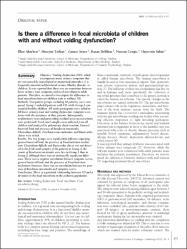| dc.contributor.author | Akarken, İlker | |
| dc.contributor.author | Tarhan, Hüseyin | |
| dc.contributor.author | Şener, Gamze | |
| dc.contributor.author | Deliktaş, Hasan | |
| dc.contributor.author | Cengiz, Nurcan | |
| dc.contributor.author | Şahin, Hayrettin | |
| dc.date.accessioned | 2023-01-02T07:27:35Z | |
| dc.date.available | 2023-01-02T07:27:35Z | |
| dc.date.issued | 2022 | en_US |
| dc.identifier.citation | Akarken I, Tarhan H, Şener G, Deliktas H, Cengiz N, Şahin H. Is there a difference in fecal microbiota of children with and without voiding dysfunction? Arch Ital Urol Androl. 2022 Dec 27;94(4):455-458. doi: 10.4081/aiua.2022.4.455. PMID: 36576461. | en_US |
| dc.identifier.issn | 1124-3562 / 2282-4197 | |
| dc.identifier.uri | https://hdl.handle.net/20.500.12809/10469 | |
| dc.description.abstract | Objective: Voiding dysfunction (VD), which encompasses many urinary symptoms that are not caused by neurological or anatomical anomalies, is a frequently encountered functional urinary bladder disorder in children. It was reported that there was an association between lower urinary tract symptoms and fecal microbiota in adult patients. Therefore, we aimed to investigate the differences in fecal microbiota between children with or without VD.
Methods: Two patient groups, including 30 patients, were compared. Group 1 included patients with VD, while Group 2 consisted of healthy children. All study participants were asked to fill lower urinary tract and voiding dysfunction symptom score forms with the assistance of their parents. Subsequently, uroflowmetry tests and postvoiding residual urine measurements were performed. Fresh stool samples were collected from all children and analyzed by polymerase chain reaction. General bacterial load and presence of Roseburia intestinalis, Clostridium difficile, Fusobacterium nucleatum, and Bacteroides clarus were tested.
Results: The two groups were significantly different regarding general bacterial load; the presence of Fusobacterium nucleatum. Clostridium difficile and Bacteroides clarus was not detected in the fresh stool samples of the patients in Group 2; the counts of Roseburia intestinalis were less in Group 1 than in Group 2, although there was no statistically significant difference. There was a negative correlation between symptom scores, general bacterial load, and the presence of Fusobacterium nucleatum. However, there was no correlation between the presence of Roseburia intestinalis and symptom scores.
Conclusions: There is a potential relationship between VD and a deviation in the fecal microbiota in the pediatric population. | en_US |
| dc.item-language.iso | eng | en_US |
| dc.publisher | PAGEPress | en_US |
| dc.relation.isversionof | 10.4081/aiua.2022.4.455 | en_US |
| dc.item-rights | info:eu-repo/semantics/openAccess | en_US |
| dc.subject | Voiding dysfunction | en_US |
| dc.subject | Fecal microbiota | en_US |
| dc.subject | Fecal microbiota change | en_US |
| dc.title | Is there a difference in fecal microbiota of children with and without voiding dysfunction? | en_US |
| dc.item-type | article | en_US |
| dc.contributor.department | MÜ, Tıp Fakültesi, Cerrahi Tıp Bilimleri Bölümü | en_US |
| dc.contributor.authorID | 0000-0002-2863-3112 | en_US |
| dc.contributor.authorID | 0000-0002-7915-2802 | en_US |
| dc.contributor.authorID | 0000-0002-4977-8310 | en_US |
| dc.contributor.authorID | 0000-0003-1061-1238 | en_US |
| dc.contributor.institutionauthor | Akarken, İlker | |
| dc.contributor.institutionauthor | Tarhan, Hüseyin | |
| dc.contributor.institutionauthor | Deliktaş, Hasan | |
| dc.contributor.institutionauthor | Cengiz, Nurcan | |
| dc.contributor.institutionauthor | Şahin, Hayrettin | |
| dc.identifier.volume | 94 | en_US |
| dc.identifier.issue | 4 | en_US |
| dc.identifier.startpage | 455 | en_US |
| dc.identifier.endpage | 458 | en_US |
| dc.relation.journal | Archivio Italiano di Urologia e Andrologia | en_US |
| dc.relation.publicationcategory | Makale - Uluslararası Hakemli Dergi - Kurum Öğretim Elemanı | en_US |


















